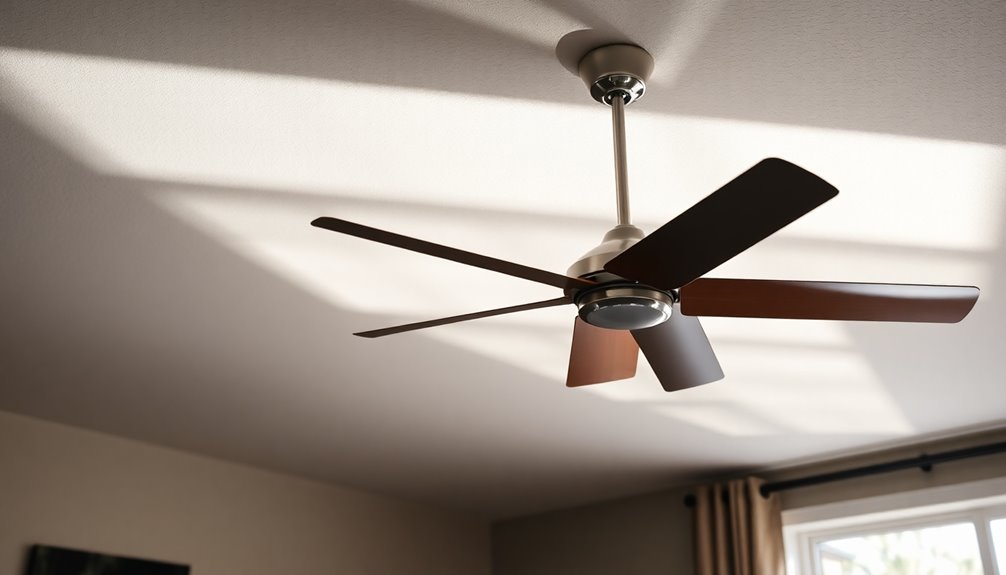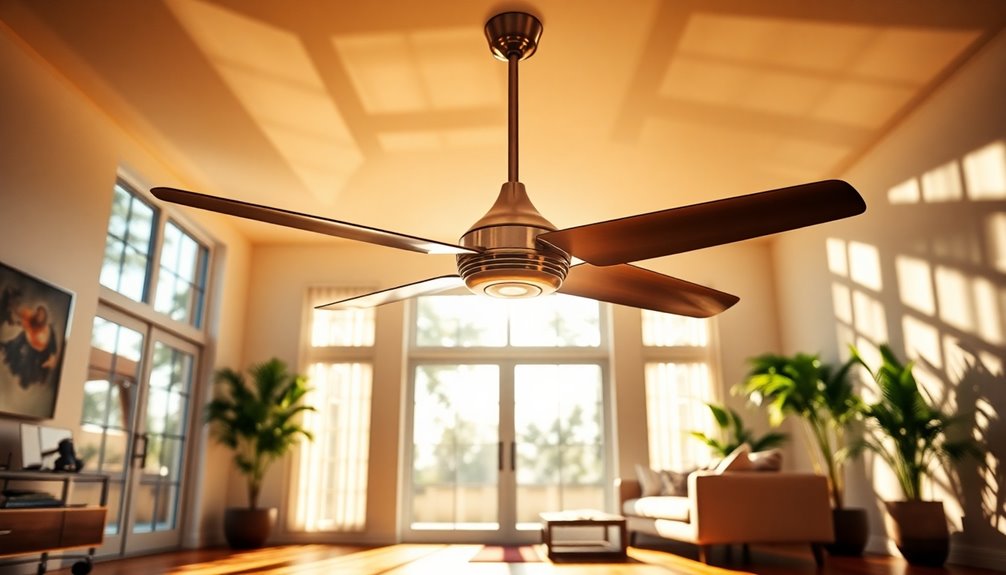Ceiling fan downrods aren't universal; they're designed to fit specific manufacturers and models. You'll find variations in length, diameter, and threading, which means you'll need to choose the right downrod for your fan. Using a non-compatible downrod can lead to installation issues and potential safety risks. To maximize airflow and guarantee your fan operates efficiently, it's vital to use the downrod recommended by the manufacturer. If you want to learn more about measuring for the right downrod or exploring alternatives, there's a lot more to discover about ceiling fans and their installation.
Key Takeaways
- Ceiling fan downrods are not universal; they vary by manufacturer, requiring specific options for compatibility.
- Downrod diameter options typically include 1/2 inch and 3/4 inch, affecting compatibility with fan weight.
- Mismatched threading types can cause installation issues, highlighting the need for manufacturer specifications.
- Correct downrod length is crucial for airflow and fan performance, making compatibility essential.
- Always consult the fan's manufacturer for the appropriate downrod to ensure safety and functionality.
Importance of Downrods

When it comes to your ceiling fan's performance, downrods play an essential role in guaranteeing stability and efficiency. These components connect the fan motor to the mounting hardware, reducing wobbling and enhancing overall air circulation.
Selecting the proper height for your ceiling fan is vital; ideally, it should sit 8-10 inches from the ceiling and at least 7 feet above the floor. This setup not only guarantees safety but also maximizes airflow.
Keep in mind that downrods aren't universal. They vary in length, diameter, and threading specifications, meaning you need to use manufacturer-specific downrods for your ceiling fan.
The correct length of downrod directly impacts both functionality and aesthetics. A well-chosen downrod contributes to the visual balance of your room while guaranteeing the fan operates effectively. Additionally, choosing the right downrod can enhance the fan's energy efficiency, which ultimately helps in reducing electricity bills.
Downrod Compatibility Issues

Choosing the right downrod for your ceiling fan can be tricky due to compatibility issues that often arise. It's important to take into account several factors to guarantee a safe and efficient installation. Here are four key points to keep in mind:
- Diameter: Downrods come in various diameters, typically 1/2 inch and 3/4 inch. Heavier ceiling fans often require the thicker 3/4 inch option for secure installation.
- Threading Type: Mismatched threading types can lead to installation issues. Some downrods feature tapered threaded ends that mightn't align properly with your fan's connection point.
- Manufacturer Specifications: Always refer to the manufacturer's specifications for your ceiling fan model. This guarantees you select a downrod that meets the requirements for both compatibility and safety.
- Downrod Length: The correct downrod length is vital for peak performance. Using the wrong length can affect airflow and the overall effectiveness of your ceiling fan.
Measuring Downrod Length

To find the right downrod length for your ceiling fan, you'll need to measure your ceiling height and account for the fan's height.
Standard lengths typically range from 2 to 10 inches for lower ceilings, but higher ceilings might need longer options.
Calculating Required Length
Calculating the required downrod length is essential for guaranteeing your ceiling fan operates effectively and safely. To achieve the best airflow and proper clearance, you'll need to measure your ceiling height and determine the appropriate downrod length.
Follow these steps to calculate your downrod:
- Measure your ceiling height.
- Determine the height of your ceiling fan.
- Decide on your desired hanging height, generally 8 feet from the floor.
- Use the formula: (Ceiling Height – Fan Height) – Desired Hanging Height.
For example, if your ceiling height is 10 feet, you'll need a 24-inch downrod to maintain proper clearance and airflow. If your ceiling is 12 feet high, a 36-inch downrod is often required.
Remember, for every foot above 9 feet in ceiling height, add an additional 12 inches in downrod length for proper installation.
Standard Length Options**
After determining the required downrod length for your ceiling fan, it's important to explore the standard length options available. Standard downrod lengths typically range from 2 to 10 inches for ceilings between 8 to 9 feet high. If your ceiling exceeds 9 feet, you'll need to add an extra 12 inches of downrod length for every foot above 9 feet.
Here's a quick reference table to help you visualize the standard downrod lengths based on ceiling height:
| Ceiling Height | Downrod Length | Recommended Hanging Height |
|---|---|---|
| 8 feet | 2 inches | 8 feet |
| 9 feet | 6 inches | 8 feet |
| 10 feet | 24 inches | 8 feet |
| 15 feet | 72 inches | 8 feet |
Using the formula (Ceiling Height – Fan Height) – Desired Hanging Length (ideally 8 feet) will help you find the right downrod length for your specific situation. Selecting the correct downrod length is essential for ensuring ideal airflow and safety during ceiling fan operation.
Types of Ceiling Fans

When it comes to ceiling fans, you'll find a variety of types that cater to different ceiling heights and room styles. Understanding these options is essential for ensuring safe installation and effective airflow.
Here are four common types of ceiling fans:
- Standard Ceiling Fans: Designed for rooms with a height of the ceiling between 8 to 9 feet, these are the most common choice for everyday use.
- Flush Mount Ceiling Fans: Perfect for ceilings under 8 feet, these fans sit close to the ceiling, providing a sleek look without sacrificing airflow.
- Dual-Head Ceiling Fans: If you need enhanced airflow in larger spaces, dual-head fans like the Harbor Breeze Twin Breeze feature two fan heads, making them ideal for specific cooling needs.
- Specialty Ceiling Fans: These include outdoor and industrial models, engineered to withstand different environmental conditions and may require specific ceiling fan downrods for proper installation. Additionally, using the correct ceiling fan downrods is crucial for maintaining optimal airflow and safety.
Alternatives to Downrods

If you're looking for alternatives to downrods, there are several options that can still keep your space cool.
Consider flush mount ceiling fans for lower ceilings, or explore portable solutions like floor and tower fans that offer flexibility.
You might also think about window air conditioning units for a more controlled cooling experience without any installation hassle.
Ceiling Fan Types
Ceiling fans come in various types that can effectively cool your space without relying on downrods.
Whether you're looking for a practical solution or simply want to avoid installation hassles, there are alternatives available that guarantee safe airflow and comfort.
Here are four types of ceiling fan alternatives:
- Flush Mount Fans: Perfect for ceilings under 8 feet, these fans don't require downrods, making them an excellent space-saving option.
- Angled Ceiling Fans: Designed for vaulted ceilings, these fans often come with adjustable mounting options, eliminating the need for downrods while guaranteeing ideal airflow.
- Tower Fans: These portable and versatile fans can be easily moved around, providing a practical cooling solution, especially in areas where you can't install a ceiling fan.
- Wall-Mounted Fans: If ceiling fans aren't an option, wall-mounted fans can deliver effective cooling and similar airflow benefits without any downrods.
Air Conditioning Options
While ceiling fans provide effective cooling solutions, air conditioning options offer powerful alternatives that can enhance comfort in your home. Air conditioning units, especially window models, are user-friendly and require minimal installation. They operate efficiently, often set to auto mode, ensuring cool air flows throughout your space without the need for ceiling fan downrods.
If you're looking for versatility, portable floor fans can easily be moved from room to room, providing airflow similar to that of ceiling fans. They're perfect for quick cooling without the commitment of installation.
Tower fans, available in various styles, including oscillating options, adapt to different spaces seamlessly, making them a stylish and practical choice for any area.
For homes with vaulted or sloped ceilings, mounted ceiling fans can deliver overhead cooling without requiring downrods, simplifying installation and optimizing air flow. This setup allows you to maintain comfort without additional hardware.
Ultimately, whether you choose air conditioning units or fans, these alternatives can greatly improve your home's interior conditions, ensuring you stay cool and comfortable in any environment.
Portable Fan Solutions
Exploring portable fan solutions offers a practical way to stay cool without the need for ceiling fan downrods. These fans provide flexibility and comfort in various settings, allowing you to easily adjust your cooling options based on your needs. Innovative candy varieties, like cotton candy grapes, can also bring a fun twist to summer gatherings. Additionally, many portable fans are designed to be energy-efficient technology, which helps reduce electricity consumption while providing maximum comfort. Moreover, understanding the importance of hydration can enhance your overall comfort during hot weather. It is also essential to ensure that your portable fans are maintained regularly to prevent fire hazards that can occur from electrical malfunctions.
Here are four great alternatives to evaluate:
- Floor Fans: These can be moved from room to room, offering powerful airflow wherever you need it.
- Tower Fans: With their sleek design, tower fans fit seamlessly into any space and often come with oscillation features to mimic the effect of ceiling fans.
- Window Air Conditioning Units: These units provide excellent cooling without installation challenges, making them ideal for spaces where ceiling fans may not be suitable.
- Battery-Operated Fans: Perfect for outdoor settings or during power outages, these fans eliminate the need for fixed installations like downrods.
Unlike ceiling fans that require specific downrod heights, these portable fans can be placed at your desired level, allowing you to enjoy comfort without the hassle of installation. Additionally, many of these devices are designed with energy-efficient models that help reduce electricity usage, making them a smart choice for environmentally conscious consumers.
Embrace the freedom and convenience of portable fans to stay cool all summer long!
Professional Installation Considerations

When it comes to installing ceiling fan downrods, professional expertise is invaluable. You want to verify that the downrod specifications match your ceiling fan model, as they aren't universal. Using the wrong type can lead to installation failures or safety hazards, so don't take any chances.
A professional installer can accurately calculate the necessary downrod length based on your ceiling height and the desired fan height. This is vital for achieving maximum airflow and confirming that your fan operates efficiently. Additionally, opting for professional installation can prevent potential issues that might arise from incorrect fitting. Properly installed downrods can also lead to increased fan efficiency, which contributes to lower energy bills.
Remember, proper installation involves turning off the power to prevent electrical accidents, and it's important to follow the manufacturer's instructions for secure attachment.
If issues like wobbling or noise arise after installation, a professional can troubleshoot these problems, often linked to incorrect downrod fitting or alignment.
Hiring an expert not only guarantees safety but also enhances performance, confirming your ceiling fan serves its purpose effectively. So, whether you're dealing with a standard or complex configuration, investing in professional installation is a wise choice for your home.
Safety and Performance Tips

Guaranteeing safety and performance with ceiling fan downrods starts with choosing the right components. To enjoy your fan's ideal operation, here's what you need to know:
- Select the Correct Downrod Length: Aim for a downrod length that positions your fan 8-10 inches from the ceiling and at least 7 feet above the floor. This setup enhances airflow and guarantees a safe environment.
- Check Compatibility of Downrods: Not all downrods are made the same. Verify the diameter and manufacturer specifications to find the right option for your fan, as this impacts fan stability.
- Secure with Correct Set Screws: Proper installation is essential. Make sure you use the correct set screws to secure the downrod snugly. This prevents wobbling and noise, guaranteeing a smooth operation.
- Consider Fan Weight: Heavier fans often require thicker downrods for added strength and stability. Don't overlook this when selecting your downrod.
Frequently Asked Questions
Do All Downrods Fit All Ceiling Fans?
No, not all downrods fit all ceiling fans. You need to check the specific compatibility for your fan model.
Most downrods come in standard sizes, but some fans require thicker options for stability. It's essential to use the manufacturer-specified downrod to avoid installation problems or safety hazards.
Always refer to your fan's manual for the correct downrod specifications and verify you're selecting the right fit for peak performance.
Are Fan Extension Poles Universal?
Fan extension poles aren't universal, so you need to choose one that matches your specific ceiling fan brand and model.
Different manufacturers use various diameters and threading types, which means using an incompatible downrod can lead to stability issues, like wobbling.
Always check the manufacturer's specifications to verify the downrod you select fits properly and meets safety standards.
It's essential for the performance and longevity of your ceiling fan.
Are Hunter Downrods Interchangeable?
Hunter downrods aren't interchangeable with downrods from other brands.
They're specifically designed to fit Hunter fans, ensuring peak performance and safety.
If you're replacing a downrod for your Hunter fan, you need to choose one that's labeled as compatible with your specific model, especially for the Hunter Original® series.
How to Know What Size Downrod for Ceiling Fan?
To know what size downrod you need for your ceiling fan, start by measuring your ceiling height.
Subtract the fan height and then the desired hanging height of 8 feet.
For ceilings around 8-9 feet, a downrod of 2-10 inches usually works.
If your ceiling's higher than that, you'll need a longer downrod, like 24 inches for 12-foot ceilings.
Always check your fan's specifications to confirm compatibility.
Conclusion
In the end, while many ceiling fan downrods might seem universal, compatibility can vary based on fan brand and design. It's essential to measure your space and choose the right length for ideal airflow. Remember, a well-placed fan not only cools your room but can also add a stylish touch. So, don't overlook those downrods! After all, who doesn't love a revitalizing breeze on a hot day? Trust me, it makes all the difference!









